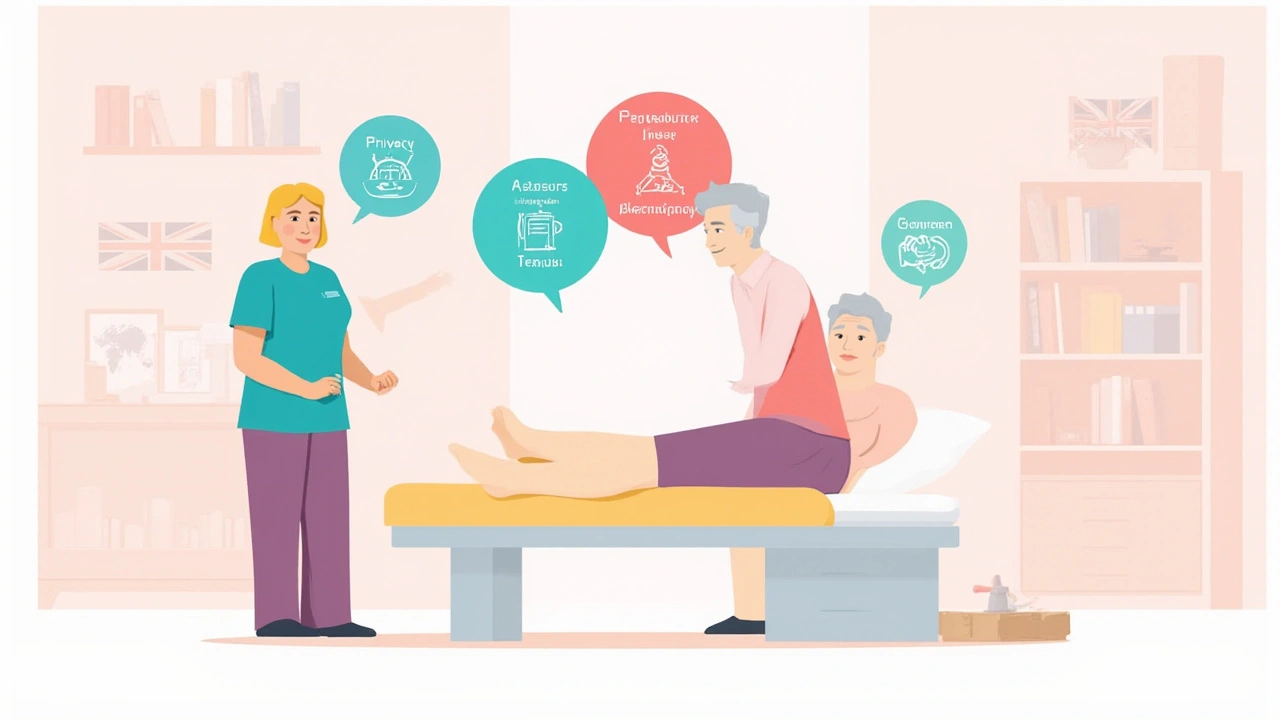How to Communicate Effectively with Your Massage Therapist: Best Ways to Get the Perfect Massage

Ever left a massage feeling disappointed, unsure if the therapist missed your aching shoulder or pressed a bit too hard? You’re not alone. Poor communication is often behind frustrating massage experiences. People sometimes freeze, or think therapists can magically guess pain points or pressure preferences. Spoiler: They can’t. Honest, direct talk with your massage therapist is the difference between a so-so rubdown and walking away feeling brand new.
Understanding Why Communication Matters
Some think massage is as simple as showing up and letting hands do their work. But every body is unique. The best therapists are skilled, sure, but not mind readers. If you shy away from saying a spot hurts or the pressure is too much, the whole session takes a nosedive. Research from the American Massage Therapy Association shows that 78% of clients who talk about their needs feel greater satisfaction after a session compared to those who stay silent. Think about it: A simple “my lower back’s tight today” is all it takes to steer a therapist’s focus. That tiny conversation shift can totally change results—but it goes both ways. Therapists relish honest feedback, since their goal is to help you walk out feeling better than you came in.
Plus, there’s more at stake than relaxation. If you don’t speak up about a surgical scar, a ticklish spot, an old injury, or even your comfort with disrobing, you risk more than disappointment. Sometimes clients stay silent out of embarrassment. That silence could mean unnecessary pain, or worse, aggravating an old injury. Massage involves trust. Communication lets your therapist work with all the facts, not just guesses.
Ever try guessing someone’s coffee order, only to get it wrong? Pretending your massage therapist has ESP is basically the same. Believe it or not, even lifelong massage professionals ask for feedback constantly—their training demands it. And, in the end, honest communication lets you get more bang for your buck. Why pay for guesswork when you could leave truly relaxed?
Getting Ready for Your Appointment: What to Share Beforehand
The conversation starts before your clothes come off. Most therapists will chat for a few minutes to learn about your reason for booking. Here’s the trick: tell them more than “I need to relax.” Pin down what hurts, what feels good, and, if you’ve had massage before, what worked (or didn’t). Are you sore from last night’s HIIT class or fighting nagging desk-work tension? Specifics help therapists decide between kneading and deep pressure or gentle stroking. If you’re nervous about privacy or new to massage, say so—pros will explain their draping policy and steps to help you stay comfortable. It sounds simple, but sometimes sharing even tiny details can seem embarrassing at first. Most therapists have heard it all, from “I snore during deep tissue” to “My feet are extremely ticklish.” The more you share, the easier it is for them to adjust everything for you.
Don’t forget about allergies and skin sensitivities. Good therapists ask about nuts, latex, or aromatherapy oils, but double-check just in case. Imagine breaking out from a scented lotion or having a respiratory flare-up mid-session. If you have a medical issue—pacemaker, pregnancy, heart condition, or recent surgery—bring it up. Certain massage techniques can be risky for some conditions. You might feel awkward the first time. That’s why therapists ask tough questions on their intake forms.
If you’re booking a special massage type (like sports, lymphatic drainage, or hot stone), use this time to clarify what to expect. Hot stones sound soothing, but if you’re allergic to heat, a quick mention saves a hassle for both sides. Your first chat sets expectations and gives you the best shot at a personalized, positive experience.

During Your Massage: Speak Up and Get What You Need
You’re on the table now. Maybe the soothing soundtrack is on. Everything seems relaxing until—ouch! Way too much pressure on your calves. Here’s where most people freeze, not wanting to offend or embarrass their therapist. But the truth? Good therapists want feedback in real time. Imagine spending 60 minutes clenching your muscles in discomfort because you’re nervous to ask for lighter pressure. You’re literally paying good money to leave stressed!
It’s okay to let your therapist know what isn’t working: “A little more to the right,” or “That spot’s sensitive.” It’s also fine to ask for changes mid-session. “Can we skip my neck?” or “Focus on my lower back, please.” You’ll never annoy a skilled therapist with clear input. They’re trained to tweak and switch things up. Silence, on the other hand, leaves you stuck with a cookie-cutter experience—exactly what you want to avoid.
Getting cold? Ask for a blanket or heating pad. Music bugging you? Request something softer. Aromatherapy smell too intense? A simple “no oils, please” works. Your comfort is literally part of their job description. If they don’t ask periodically if the pressure is good or if you’re comfortable, just pipe up. One recent client survey in London found that nearly 55% of clients left feeling underwhelmed because they were too shy to say what they really wanted during the session. One clear, honest comment can make the difference between “meh” and “magic.” The goal is to feel pampered, safe, and cared for—and therapists appreciate a partner, not a mindreader.
After the Massage: Feedback Makes a Difference
So, you’re dressed, feeling looser and maybe walking a little taller. The communication shouldn’t stop now. “How was that for you?” isn’t small talk—it’s real talk. Honest feedback about what felt great, what could be better, or what you’d like to focus on next time helps your therapist keep improving. Maybe you wished the shoulders got a bit more attention. Or next time, you hope to skip the arms. Say it directly. Most therapists keep notes to make your future visits even better. This is also the time to discuss how you felt during and after—did the pressure stay comfy throughout, or were there moments it got too heavy?
Here’s another reason to give helpful feedback: The right info helps therapists spot trends with your muscles, posture, or daily habits. If your lower back loosens up with certain techniques, your therapist can plan focused sessions down the road. A good therapist loves a repeat client who shares what’s changed (or not) between sessions. If you felt a little dizzy after the massage, tell them. Sometimes deep work on muscles can stir up old tension or even toxins—take their advice about water, rest, or stretching. A 2023 survey by Massage Therapy Magazine found therapists who routinely get detailed feedback reported 31% more repeat bookings than those who don’t ask. That’s not just good business; it’s smart care.
If something was off—say, the oils caused a rash or a technique irritated an old injury—a quick chat saves you both hassle later. Solid communication after a massage sets you up for an even better next visit.

Tips for Building a Healthy Client-Therapist Relationship
Want every massage session to just keep getting better? It usually comes down to the relationship you build with your therapist. Trust is key. The more open you are, the more a therapist can tailor each visit for your needs. Don’t be afraid to try out different therapists until you find one whose style and personality “click” for you. It’s totally normal—just like choosing a doctor, a barber, or a mechanic. The massage world’s not one-size-fits-all.
Reschedule when you’re sick or running a fever. Therapists appreciate honest heads-up rather than faking your way through a session. If you’re changing medications or going through rehab for an injury, keep your therapist in the loop. And, of course, tipping fairly or giving sincere verbal thanks never goes unnoticed.
If privacy or modesty concerns have kept you from booking a massage, speak up at your first session. Good therapists have tons of ways to help—adjusting draping, letting you keep parts of clothing on, or even doing a full session with you lying face up if that’s more comfortable. The more you relax into honest conversation, the easier it gets to get exactly what you want, every single time.
Most important tip? Remember, therapists are there for you. It’s a shared session, not a one-way street. When you both work together—honestly and openly—you get the full benefit from every minute on that table. That’s how you walk away truly relaxed, pain-free, and ready for anything—whether that’s another tough week at work or another round with the gym weights.
- Share your real goals for the session every time.
- Mention all injuries, allergies, and skin sensitivities.
- Never be afraid to direct changes during the massage.
- Give honest feedback after, to help your therapist improve future visits.
- Switch therapists if you ever feel uncomfortable or unheard.
If every client spoke up, there’d be a lot more happy faces leaving massage rooms. Communication is your most powerful tool—and a surefire way to make your next session exactly what you want it to be.
